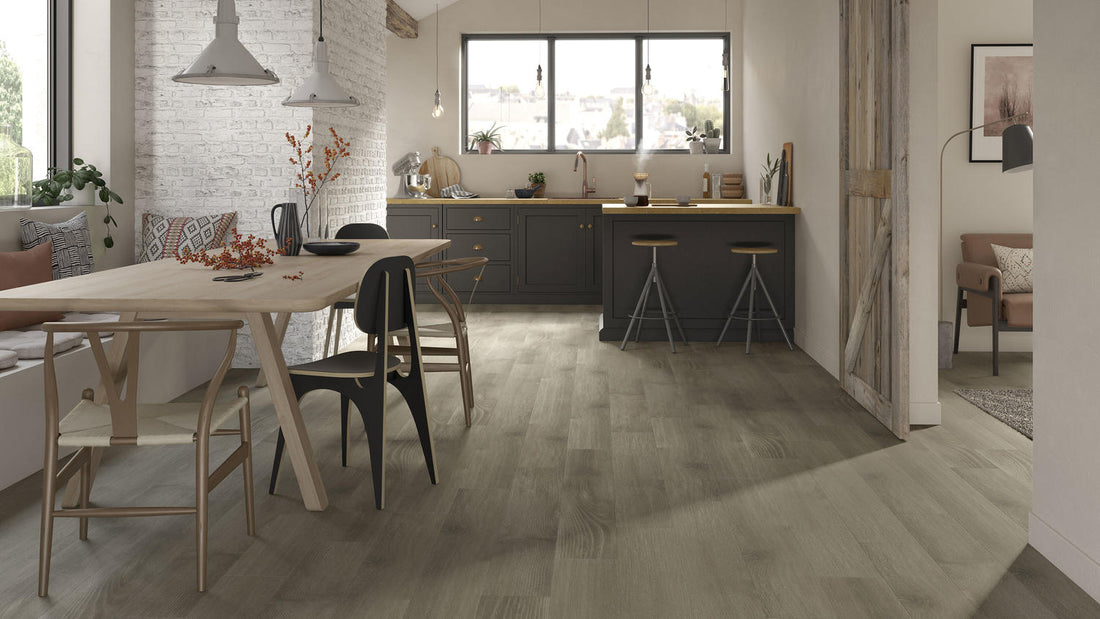So many questions to learn about vinyl flooring before you make a decision. I really wish I had an epic article like this to help guide me before I made the decision. I hope this can help you on your learning and buying journey. Let’s start off by describing different types of Vinyl flooring.
Note: this is a guide. Always follow manufacturer instructions and get advice / guidance from professionals. This is an article on the internet... fabulous information below to help with your floor buying journey. But do your own research and speak to a professional before any large decisions are made.
There are several types of vinyl flooring available, each with its own characteristics and features. Here are some of the most common types of vinyl flooring, along with their pros and cons:
Sheet Vinyl Flooring
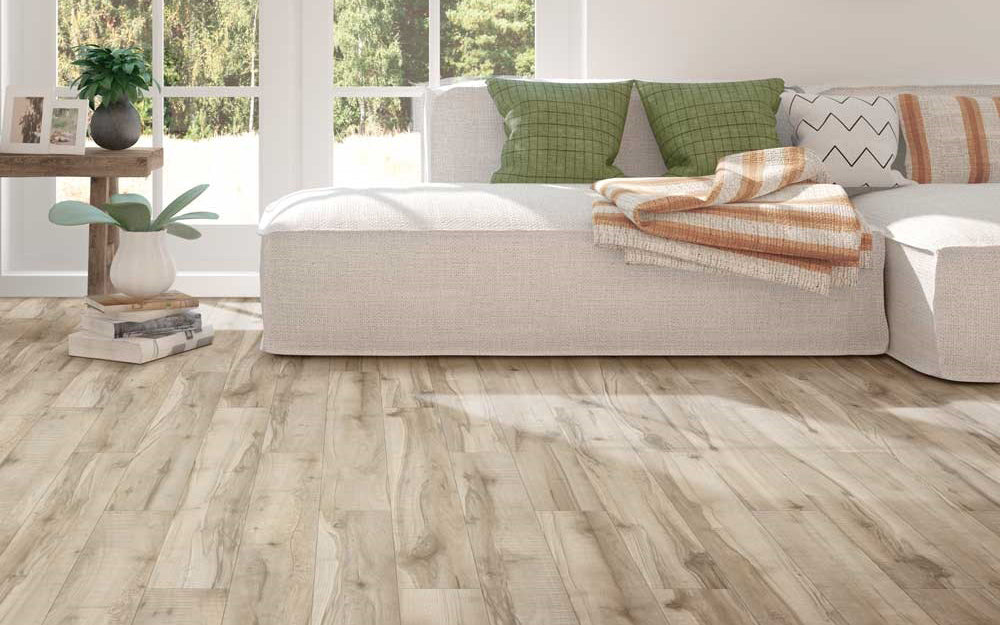
Sheet vinyl flooring is a type of vinyl flooring that comes in large rolls and can be cut to fit the dimensions of the room. It is typically available in a wide range of colors and patterns, making it a popular choice for both residential and commercial applications. Some of the pros and cons of sheet vinyl flooring include:
Pros:
- Easy to clean and maintain
- Durable and long-lasting
- Moisture-resistant and waterproof options are available
- Offers good sound insulation
- Can be installed over a variety of subfloors
Cons:
- Difficult to repair if damaged
- Installation can be challenging and requires skill
- Not as visually appealing as other types of flooring
Luxury Vinyl Tile (LVT)
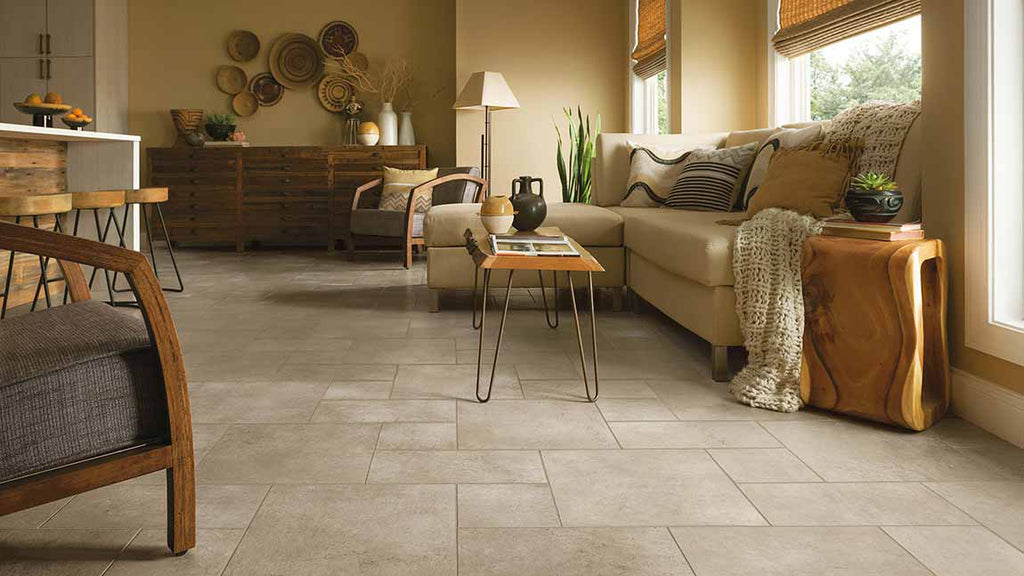
Luxury vinyl tile (LVT) is a type of vinyl flooring that is designed to look like natural materials such as wood, stone, or tile. It is made up of multiple layers, including a wear layer, a design layer, a vinyl core, and a backing layer. Some of the pros and cons of LVT include:
Pros:
- Highly durable and scratch-resistant
- Water-resistant and waterproof options are available
- Easy to clean and maintain
- Wide range of design options is available
- Can be installed over different types of subfloors
Cons:
- May not look as real as natural materials
- Can be more expensive than other types of vinyl flooring
- Might require professional installation
Luxury Vinyl Plank (LVP)
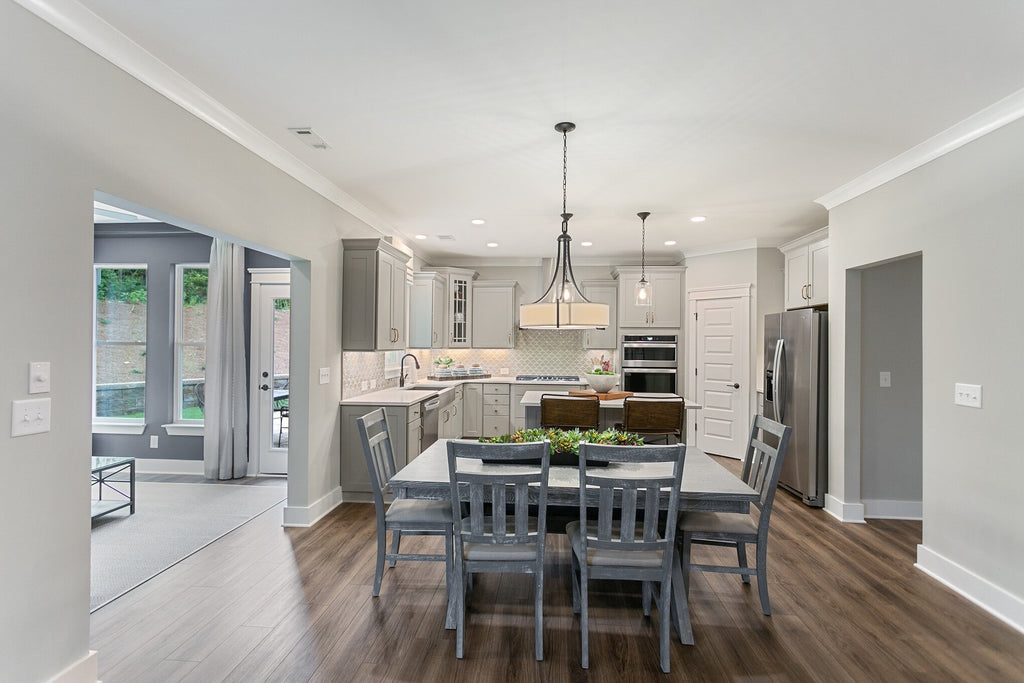
Luxury vinyl plank (LVP) is similar to LVT, but designed to mimic the look of hardwood flooring. It is typically made up of multiple layers, including a wear layer, a design layer, a vinyl core, and a backing layer. Some of the pros and cons of LVP include:
Pros:
- Highly durable and scratch-resistant
- Water-resistant and waterproof options available
- Easy to clean and maintain
- Provides the look of hardwood without the cost or maintenance
- Can be installed over a variety of subfloors
Cons:
- May not look as authentic as hardwood flooring
- May require professional installation
- Some types may be more expensive than other vinyl flooring options
- not as common to see this flooring type as an option. SPC and WPC rigid core dominate the market place now
WPC (Wood Plastic Composite) Vinyl Flooring
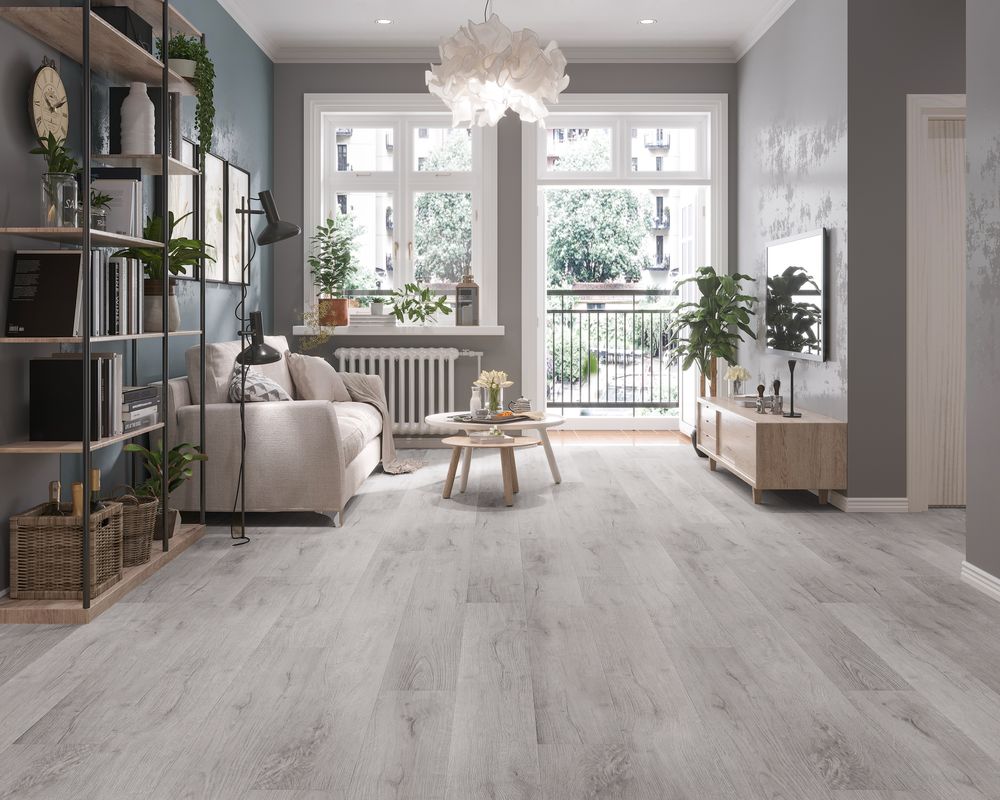
WPC vinyl flooring is a type of vinyl flooring that is made up of multiple layers, including a wear layer, a vinyl core, a printed design layer, and an underlayment. It is designed to mimic the look of hardwood flooring, but is more durable and moisture-resistant. Some of the pros and cons of WPC vinyl flooring include:
Pros:
- Highly durable and moisture-resistant
- Easy to clean and maintain
- Provides the look of hardwood without the cost or maintenance
- Can be installed over a variety of subfloors
- lighter and thicker than SPC, which makes it a little more DIY friendly installation
- the wood in the core tends to make the floor feel warmer than its SPC cousin, and the wood fibre in the core also tends to make the floor feel softer underfoot compared to SPC
- cork is often added into the overall WPC product, which adds even more to both the warmth and softer feel underfoot
Cons:
- May not look as authentic as real hardwood flooring
- May be (usually is) more expensive than other vinyl flooring options
- Could require professional installation
- its overall thickness is thicker than SPC. This is a Pro as it is easier to install, but it means there is less square feet in a box which means may mean the products ships less efficiently. This is a small con, it just means the landed cost can be higher per sqft
SPC Vinyl Flooring
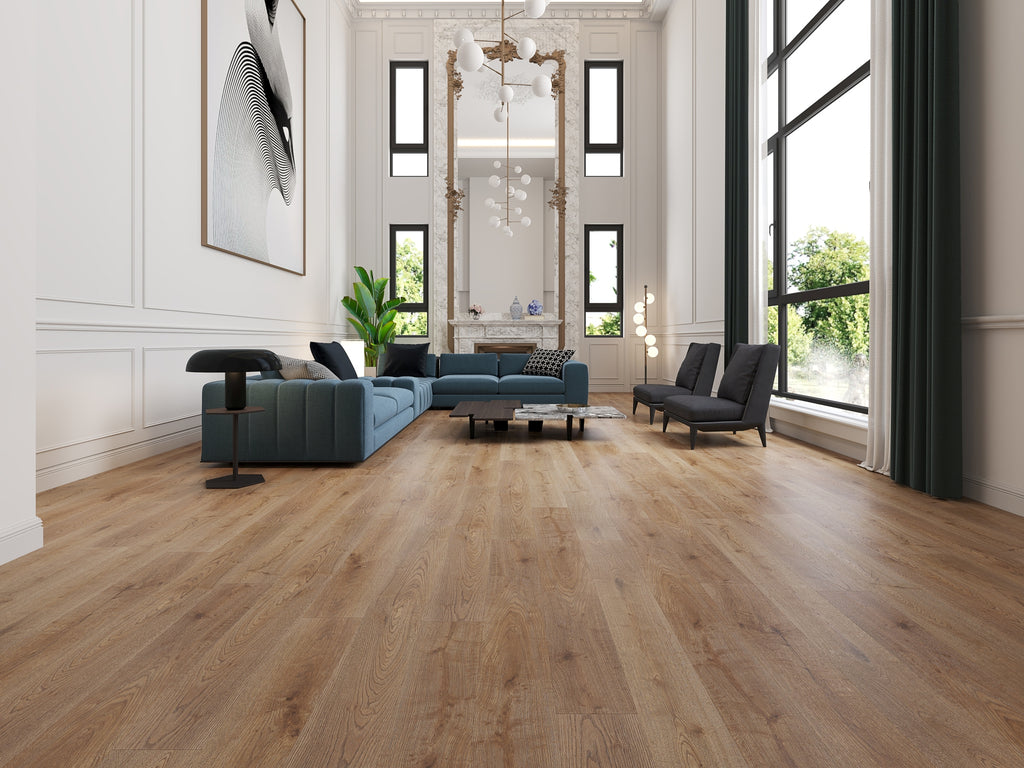
SPC stands for Stone Plastic Composite. SPC vinyl flooring is made up of a mixture of limestone and PVC resin, making it extremely durable and resistant to water, stains, and scratches. Here are the pros and cons of SPC vinyl flooring:
Pros:
- Waterproof: SPC vinyl flooring is completely waterproof and can be installed in areas that are prone to moisture, such as bathrooms and kitchens
- Scratch and dent-resistant: The limestone in the flooring makes it very resistant to scratches and dents, making it ideal for high-traffic areas
- Easy to install: SPC vinyl flooring is designed with a click-lock system, making it easy to install
- Low maintenance: SPC vinyl flooring is very easy to clean and maintain.
- Durable: Due to its tough composition, SPC vinyl flooring is extremely durable and can last for years.
Cons:
- SPC vinyl flooring is colder than WPC or other vinyl underfoot
- SPC vinyl flooring can feel harder underfoot than other vinyl options. This is subtle, but it is fair to say SPC is slightly harder and colder underfoot
- Can be heavy: SPC vinyl flooring can be heavy (very heavy) and difficult to handle during installation
- SPC rigid core is thinner than WPC rigid core vinyl floors. When doing a renovation, but aware of the replacement flooring thickness. If you door jams were cut previously for lets say a 12mm laminate, a 15mm engineered hardwood floor, or a tile floor, then the replacement SPC vinyl floor will be much thinner. This needs to be factored in if using SPC vinyl to replace a previous floor
Loose Lay Vinyl Flooring
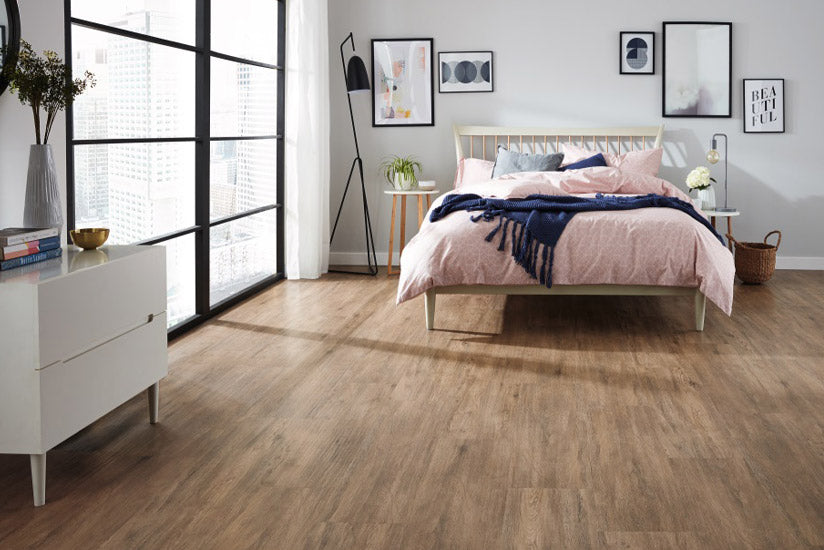
Loose lay vinyl flooring is designed to be laid without any adhesive and relies on its weight and the friction between the floor and the planks to stay in place. Here are the pros and cons of loose lay vinyl flooring:
Pros:
- Easy to install: Loose lay vinyl flooring is very easy to install, as it does not require any adhesive. That said, some glue assist is often recommended
- Warm and Quiet: Loose lay vinyl flooring is known for being quiet underfoot and often a little warmer than SPC vinyl
- Cost-effective repair: Loose lay vinyl flooring is the easiest vinyl to replace when a plank is damaged. It is a fabulous option for rental units or higher risk situations that a small number of planks can be damaged. Very easy to pull an old plank up and replace (as there is no click lock to deal with and either no glue or less glue in a glue assist situation)
Cons:
- Not 100% waterproof: Loose lay vinyl flooring is not suitable for areas that are exposed to moisture, as the planks are not attached to each other
- May shift over time: Since it relies on friction to stay in place, loose lay vinyl flooring may shift over time. Glue assist helps solve this
- 5mm is the common thickness, so it is more expensive than 2mm or 3mm dry back vinyl product
- Limited visual options. This product type is less popular than rigid core options so the colour options are much less
Dry Back Vinyl Flooring
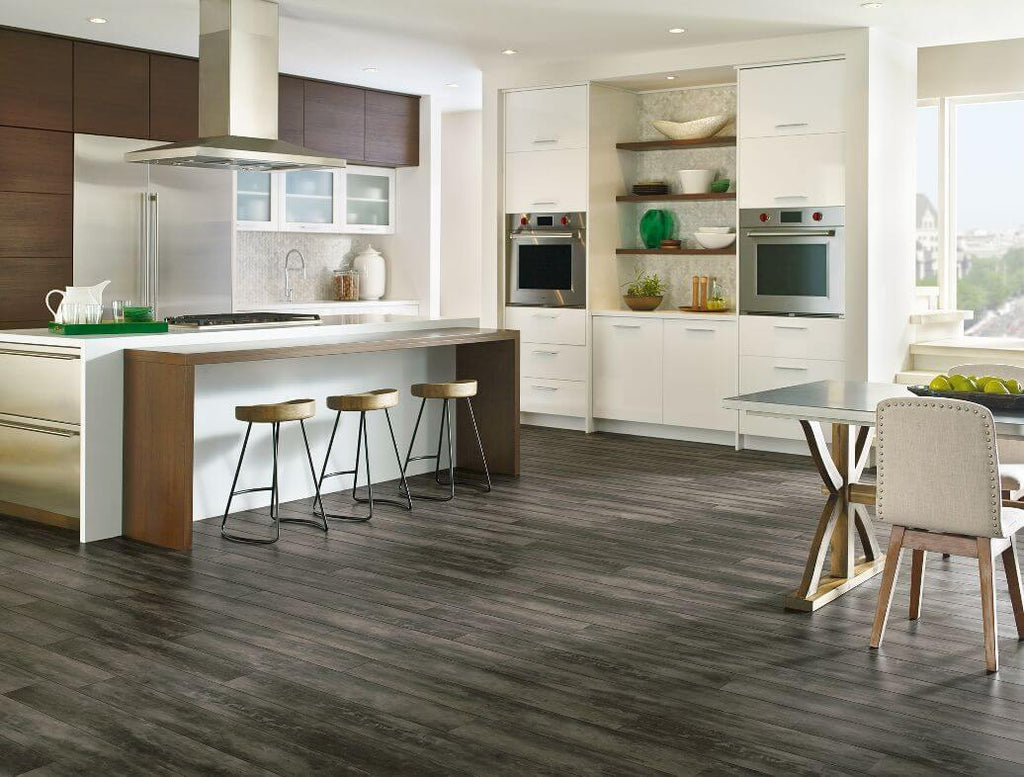
Dry back vinyl flooring, also known as glue-down vinyl flooring, is installed by applying adhesive to the subfloor and laying the vinyl planks on top. Here are the pros and cons of dry back vinyl flooring:
Pros:
- Durable: Dry back vinyl flooring is very durable and can withstand heavy foot traffic
- ideal for commercial projects
- Wide range of design options: Dry back vinyl flooring is available in a wide range of colours, patterns, and textures, giving you plenty of design options
- Easy to maintain: Dry back vinyl flooring is easy to clean and maintain
- It is low cost (very low compared to rigid core), the thinnest vinyl option and typically the lowest cost
Cons:
- Difficult to remove: Once installed, dry back vinyl flooring can be difficult to remove
- Not suitable for DIY installation: Dry back vinyl flooring is not recommended for DIY installation, as it requires specialized tools and techniques. This is a floor that is most commonly used for commercial projects
- smaller planks
- thinner product. Subfloor is always important, but with dry back vinyl the planks are very thin (2mm, 2.5mm or 3mm) and the subfloor must be near perfect to avoid issues telegraphing through the vinyl
What Is Rigid Core Vinyl? Does It Include SPC and WPC?
Rigid core vinyl is a type of vinyl flooring that has a sturdy, rigid core layer. It is typically made up of a combination of vinyl, limestone, and stabilizers. Both SPC and WPC are types of rigid core vinyl flooring. SPC stands for Stone Plastic Composite, and it is made up of a solid, stone-plastic composite core. WPC, on the other hand, stands for Wood Plastic Composite, and it has a core that is made up of wood-plastic composite materials.
The main difference between SPC and WPC is the core material. SPC has a more rigid and dense core, while WPC has a softer and more flexible core. Both types of rigid-core vinyl flooring are highly durable, waterproof, and easy to maintain. They are also resistant to scratches and stains.
As for loose lay and dry back vinyl, they are not types of rigid core vinyl. Loose lay vinyl does not have a core layer and relies on its weight and the friction between the floor and the planks to stay in place. Dry back vinyl has a flexible, adhesive backing that is applied to the subfloor. Both types are generally less rigid than rigid core vinyl and may require more maintenance over time.
Difference Between Laminate And Vinyl Flooring?
Laminate flooring is made of a composite material that consists of several layers of different materials pressed together. The top layer is a high-resolution image of wood, stone, or another natural material, covered with a clear protective layer. The middle layer is usually made of fiberboard, and the bottom layer is a stabilizing layer that resists moisture.
Vinyl flooring, on the other hand, is made of a type of plastic material called polyvinyl chloride, or PVC. It comes in sheets, tiles, or planks, and can be installed with adhesive or as a floating floor. Vinyl flooring can also have a printed design or texture to mimic natural materials such as wood or stone.
Here are some benefits of laminate flooring:
Durability: Laminate flooring is very durable and can withstand heavy foot traffic, making it a good choice for high-traffic areas like living rooms or hallways.
Easy to clean: Laminate flooring is easy to clean and maintain, as it doesn't stain easily and can be swept or vacuumed.
Affordable: Laminate flooring is usually less expensive than hardwood or tile flooring, making it a good option for budget-conscious homeowners.
Easy to install: Laminate flooring can be installed quickly and easily, as it usually comes in planks or tiles that snap together without the need for glue or nails.
Variety of styles: Laminate flooring comes in a wide range of styles, colors, and textures, so you can find a look that matches your home decor.
Resistant to fading: Laminate flooring is resistant to fading, so it can maintain its color and appearance over time.
And here are some benefits of vinyl flooring:
Water-resistant: Vinyl flooring is water-resistant and can be installed in areas with high humidity, such as bathrooms and kitchens.
Easy to clean: Vinyl flooring is easy to clean and can be swept, vacuumed, or mopped with a damp cloth.
Durable: Vinyl flooring is durable and can withstand heavy foot traffic, making it a good choice for high-traffic areas.
Soft and comfortable: Vinyl flooring has some cushioning, making it more comfortable to stand on for long periods of time.
Easy to install: Vinyl flooring can be installed quickly and easily, either with adhesive or as a floating floor.
Versatile: Vinyl flooring comes in a variety of colors and patterns, including wood and stone looks, so you can find a look that matches your style.
In terms of comparing the two types of flooring, laminate is usually more scratch-resistant than vinyl and can look more like natural wood or stone. However, vinyl is more water-resistant than laminate and can be installed in areas where moisture is a concern. Laminate flooring can be a little more expensive than vinyl, but it can also be more durable and long-lasting. Ultimately, the choice between laminate and vinyl flooring will depend on your personal style, budget, and the needs of your home.
Vinyl vs Ceramic Tile: What Are Their Similarities and Differences:
Vinyl flooring and ceramic tile are two popular options for flooring, and there are several similarities and differences between them:
Similarities:
- Both vinyl flooring and ceramic tile are hard, durable surfaces that can withstand heavy foot traffic.
- Both materials are available in a variety of colors and patterns to suit different design aesthetics.
- Both are relatively easy to clean and maintain, though ceramic tile may require
- periodic resealing to maintain its waterproof properties.
Differences:
- Vinyl flooring sheets and dryback vinyl are typically less expensive than ceramic tile, though luxury vinyl tiles (LVT) and rigid core planks can be more expensive.
- Ceramic tile is generally more durable and longer-lasting than vinyl flooring and can withstand extreme temperatures, moisture, and heavy impacts.
- Vinyl flooring is softer and more flexible than ceramic tile, making it more comfortable underfoot and easier to install.
- Vinyl flooring is completely waterproof, while ceramic tile is only water-resistant, meaning that it can resist water to a certain extent but can still be damaged if water penetrates the grout lines.
- Ceramic tile is more difficult to install than vinyl flooring, as it requires a skilled installer and a more complex installation process, including grouting and sealing.
Vinyl flooring and engineered flooring are both popular options for flooring, but they have some key similarities and differences.
Similarities:
- Both can mimic the look of hardwood, tile, or other natural materials.
- Both are available in a variety of colors and styles.
- Both are considered durable and long-lasting flooring options.
- Both can be installed with a variety of installation methods, such as floating, glued down or nailed down.
- Both are relatively easy to clean and maintain.
Differences:
- Vinyl flooring is made from synthetic materials, while engineered flooring is made from natural wood veneer and plywood layers.
- Vinyl flooring is often more affordable than engineered flooring.
- Vinyl flooring is typically more water-resistant and better suited for areas with high moisture levels, while engineered flooring can be prone to water damage if not properly sealed.
- Engineered flooring can be sanded and refinished once (or multiple) times, while vinyl flooring cannot be sanded or refinished.
- Engineered flooring has a more authentic wood look and feel (because it is real hardwood!), while vinyl flooring can have a more uniform and synthetic look.
- Engineered flooring is often considered a higher-end option and can increase the resale value of a home, while vinyl flooring is seen as a more budget-friendly option.
Overall, the choice between vinyl flooring and engineered flooring will depend on a variety of factors, including a budget, desired aesthetic, and the specific needs of the space in question.
How do you install SPC Vinyl Flooring?
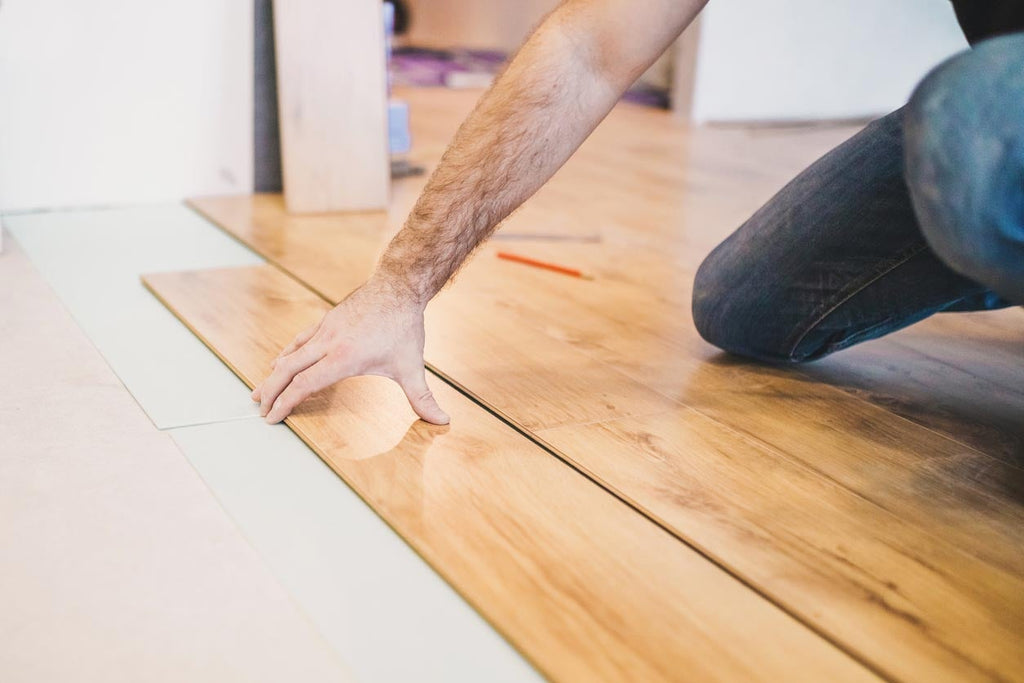
If you're looking to install SPC vinyl flooring, it's important to properly prepare your subfloor first. This will help ensure a smooth, level surface and a long-lasting installation. Here are some step-by-step guidelines to help you get started:
- Prepare your subfloor: Your subfloor should be clean, dry, and level before installing SPC vinyl flooring. Remove any existing flooring, and fill in any gaps or cracks in the subfloor with a self-leveling compound if necessary. Do not skip this step, take your time and focus are a great subfloor. The top reason future issues emerge is because the subfloor was not properly prepared.
- Measure your space: Measure the length and width of your room to determine how much flooring you'll need. Be sure to add about 10% extra to account for waste and cutting.
- Acclimate your flooring: SPC vinyl flooring can expand and contract with temperature and humidity changes, so it's important to acclimate it to the room where it will be installed. Leave the flooring in the room for 48 hours before installation.
- Install underlayment: If you're installing over a concrete subfloor, it's recommended to install an underlayment first to help with moisture and sound insulation. If you're installing over a plywood subfloor, an underlayment may not be necessary, but you can still install one for added cushioning and insulation.
- Start laying your flooring: Begin laying your SPC vinyl flooring from the longest wall in the room, working your way towards the opposite wall. Use spacers to maintain 3/8” or ¼” gap between the flooring and the wall, which will allow for expansion and contraction.
- Cut your flooring to fit: Use a utility knife or saw to cut your flooring to fit around doorways, corners, and other obstacles in the room.
- Install the last row: The last row of flooring may need to be cut to fit, depending on the size of the room. Use a pull bar and rubber mallet to snugly fit the final row into place.
- Install trim and transition pieces: Install baseboards, quarter rounds, and other trim pieces to cover the gaps between the flooring and the wall. Install transition pieces between rooms and different flooring types.
Tools you'll need to install SPC vinyl flooring include a measuring tape, utility knife, saw, spacers, pull bar, rubber mallet, and underlayment (if not already attached to the floor).
Remember, proper subfloor preparation is key to a successful SPC vinyl flooring installation. Take your time and follow these guidelines to ensure a beautiful and long-lasting result.
Do I Need To Acclimate My Vinyl Flooring Before I Install?
Yes, you should acclimate your vinyl flooring before installation. Acclimatization refers to the process of letting the flooring adjust to the temperature and humidity conditions of the room where it will be installed. This is important because vinyl flooring can expand and contract based on changes in temperature and humidity, which can affect the overall installation.
To acclimate your vinyl flooring, you should leave the flooring in the room where it will be installed for at least 48 hours before installation. This will allow the flooring to adjust to the temperature and humidity conditions of the room, which will help prevent issues with buckling, warping, or gaps in the flooring after installation.
If you don't properly acclimate your vinyl flooring before installation, you may run into problems such as gaps between planks, buckling, or warping. This can be especially problematic if the room has a different temperature or humidity level than where the flooring was stored before installation. Additionally, if you don't acclimate your flooring and it expands or contracts after installation, it may void the warranty on the flooring.
In summary, acclimatization is an important step in ensuring a successful vinyl flooring installation. Be sure to follow the manufacturer's guidelines for acclimating your specific type of vinyl flooring to avoid potential issues.
Can I Install SPC Vinyl Flooring In The Kitchen? In The Bathroom? What About WPC Vinyl Flooring?

Yes, you can install SPC vinyl flooring in both the kitchen and bathroom. SPC vinyl flooring is a great option for these areas because it is waterproof, durable, and easy to maintain. It can withstand spills, moisture, and high traffic without warping or deteriorating.
As for WPC vinyl flooring, it is also a great option for the kitchen and bathroom due to its waterproof and durable properties. However, it may not be as ideal as SPC vinyl flooring in terms of dent and scratch resistance. WPC vinyl flooring is also slightly softer and more flexible than SPC vinyl flooring, which can make it more prone to indentation and wear over time.
Ultimately, both SPC and WPC vinyl flooring are good options for kitchens and bathrooms, and the decision between the two will depend on your specific needs and preferences. Whichever type you choose, be sure to follow the manufacturer's guidelines for proper installation and maintenance to ensure long-lasting and beautiful flooring.
When installing a floating SPC vinyl floor in the bathroom, it is generally recommended to seal the edges with silicone sealant. This can help prevent moisture from seeping underneath the flooring and potentially causing damage to the subfloor or the flooring itself.
If water does get underneath the flooring, it can cause a variety of issues. For example, if the subfloor is not properly protected, water can cause the subfloor to deteriorate, which can lead to structural damage and potentially hazardous conditions. Additionally, water can cause the flooring to warp, buckle, or become discolored, which can negatively impact the overall appearance of the bathroom.
To prevent water damage to your SPC vinyl flooring, it is important to ensure that the subfloor is properly prepared before installation and that the edges of the flooring are sealed with a high-quality silicone sealant. Additionally, be sure to clean up any spills or moisture on the surface of the flooring as soon as possible to prevent it from seeping underneath.
Overall, taking the necessary precautions to protect your SPC vinyl flooring from water damage can help ensure a long-lasting and beautiful bathroom floor.
But SPC Vinyl Is 100% Waterproof, So Why Do I Need To Seal It When Installing It In A Bathroom?
While SPC vinyl flooring is waterproof and highly resistant to moisture, it is not completely impervious to water. Water can still seep through any gaps or openings between the planks or around the edges of the flooring, which can cause damage to the subfloor or create an environment for mold and mildew growth.
Sealing the edges of your SPC vinyl flooring with a silicone sealant can help prevent moisture from seeping underneath the flooring and causing damage in a bathroom. This is especially important in areas like bathrooms, where there is typically more exposure to water and humidity.
In addition to sealing the edges of the flooring, it is also recommended to properly prepare the subfloor before installation to create a flat, level, and dry surface for the flooring. This can also help prevent any moisture-related issues that may occur.
Overall, while SPC vinyl flooring is highly resistant to moisture and can withstand exposure to water, sealing the edges is an additional measure that can help ensure the longevity and durability of your flooring.
I am doing a flooring installation. Removing carpet is costly and takes time. Can I just install SPC vinyl flooring directly over the carpet?
No, it is not recommended to install SPC vinyl flooring directly over the carpet. SPC vinyl flooring is a floating floor system, which means that it needs to be installed over a solid, stable, and level subfloor. Carpet is not a suitable subfloor for SPC vinyl flooring because it is not stable and can cause the flooring to shift or buckle over time.
Installing SPC vinyl flooring over carpet can also create an uneven surface, which can compromise the integrity of the flooring and cause it to wear unevenly. Additionally, carpet fibers can potentially interfere with the locking mechanisms of the SPC vinyl flooring, preventing them from properly locking together.
If you are looking to install SPC vinyl flooring, it is recommended to remove the carpet first and prepare the subfloor accordingly. This may involve cleaning the subfloor, leveling any uneven areas, and installing a suitable underlayment. While removing carpet may be time-consuming and costly, it is necessary to ensure a proper and long-lasting installation of your SPC vinyl flooring.
My subfloor is uneven. Can I install vinyl over the subfloor anyway?
It is not recommended to install vinyl flooring over an uneven subfloor. An uneven subfloor can cause the vinyl planks to shift or buckle, leading to a damaged or uneven flooring surface.
Before installing vinyl flooring, it is important to ensure that the subfloor is flat and level. This may require leveling compounds, floor patching, or even subfloor replacement in severe cases.
Ignoring an uneven subfloor can not only result in a poor-looking flooring installation, but it can also compromise the structural integrity of the floor over time.
We say, ‘Pay now or pay more later’. Meaning many people do not want to pay to have their subfloor properly leveled… but if you try and avoid doing that to save money at the start of the job, it means problems in the future. And future problems usually cost more to fix, as you may need to remove your floor, level the subfloor, and need to purchase another floor. It can be a very expensive mistake to ignore an uneven subfloor.
It is always best to properly prepare the subfloor before installing any type of flooring to ensure a successful and long-lasting installation. Pay upfront, or pay more later.
Is Vinyl waterproof? Are all types of vinyl waterproof?
Vinyl flooring can be waterproof, but not all types of vinyl flooring are created equal when it comes to water resistance.
SPC (Stone Plastic Composite) and WPC (Wood Plastic Composite) vinyl flooring is both waterproof, meaning they can withstand exposure to water without getting damaged. These types of vinyl flooring are made with a rigid core and a wear layer that is highly resistant to moisture, making them ideal for areas that are prone to spills and moisture, such as bathrooms, kitchens, and basements.
Loose lay and dry back vinyl flooring are not waterproof. Loose lay vinyl flooring is designed to be laid without any adhesive and relies on its weight and the friction between the floor and the planks to stay in place, so it is not suitable for areas that are exposed to moisture. Dry-back vinyl flooring requires an adhesive to be applied during installation, and while it is more water-resistant than loose lay vinyl flooring, it is not completely waterproof.
It is important to note that while SPC and WPC vinyl flooring is waterproof, the seams and edges of the flooring are still susceptible to water damage. Proper installation and maintenance, including sealing the edges and cleaning up spills promptly, can help prevent water damage and ensure the longevity of your vinyl flooring.
Why are Loose Lay / Looselay vinyl floor not considered 100% waterproof?
Loose lay vinyl flooring is not completely waterproof because it does not have a locking system to seal the edges of the planks together, leaving gaps between the planks where water can seep through. While the planks themselves are made with water-resistant materials, such as vinyl and fiberglass, water can still penetrate through the gaps and potentially cause damage to the subfloor.
Furthermore, while loose lay vinyl flooring is designed to be laid without adhesive, it still needs a stable and level subfloor to prevent any movement or shifting of the planks. Any unevenness or instability in the subfloor can cause the planks to shift or buckle, creating gaps where water can seep through and potentially cause damage.
Overall, while loose lay vinyl flooring is water-resistant and can withstand exposure to moisture to some degree, it is not completely waterproof due to the gaps between the planks. As such, it is not recommended for use in areas that are prone to excessive moisture, such as bathrooms or basements, unless additional measures are taken to prevent water penetration, such as sealing the edges or using a suitable waterproof adhesive and glue down the loose lay planks. Making it more watertight and protecting the subfloor from excessive moisture.
What is the wear layer on vinyl? What is it made of?

Vinyl flooring is a popular choice for its durability, affordability, and ease of maintenance. The top wear layer is an important component of vinyl flooring as it provides protection against daily wear and tear.
The wear layer is the topmost layer of vinyl flooring and is designed to resist scratches, scuffs, and other types of damage. It is typically made of a clear, transparent material that is tough and resilient. This layer is responsible for protecting the design and pattern of the vinyl flooring beneath it.
The material used for the wear layer can vary, but it is usually made from a type of plastic, such as polyurethane or PVC. These materials are known for their durability and resistance to abrasion, making them ideal for use in high-traffic areas.
The thickness of the wear layer can also vary, with common options being 0.3mm and 0.5mm. The difference between the two thicknesses is the amount of protection they provide. A 0.5mm wear layer is thicker and provides more protection than a 0.3mm wear layer. This makes it a better option for high-traffic areas, such as commercial spaces or homes with pets and children.
In summary, the top wear layer of vinyl flooring is an essential component that provides protection against daily wear and tear. It is typically made of a clear, tough, and resilient plastic material such as polyurethane or PVC. The thickness of the wear layer can vary, with 0.5mm being thicker and offering more protection than 0.3mm.
Vinyl flooring is an eco-friendly flooring option. Many manufacturers use recycled materials in the production of vinyl flooring, such as post-consumer recycled content and industrial waste. Additionally, vinyl flooring is highly durable and can last for many years, reducing the need for frequent replacement and waste disposal.
Some types of vinyl flooring, such as SPC and WPC, are also highly resistant to impact, making them ideal for high-traffic areas and homes with pets and children. They are also resistant to scratches and stains, making them easy to maintain and clean.
Another interesting fact about vinyl flooring is that it can be made to mimic the look of natural materials, such as hardwood, stone, and ceramic tiles. This means you can enjoy the aesthetic appeal of natural materials at a more affordable price point, while also benefiting from the added durability and water resistance of vinyl flooring.
can you use vinyl flooring on walls?
Yes, vinyl flooring can be used on walls as a creative and unique design element. Installing vinyl flooring on a wall can add texture, color, and a modern look to any room.
To install vinyl flooring on a wall, it is important to ensure that the wall is clean, dry, and smooth. You may also need to use adhesive to ensure that the vinyl planks or tiles stay in place.
Vinyl flooring can be used on any interior wall surface, including feature walls, accent walls, and backsplashes. It is important to note that some vinyl flooring may not be suitable for high-temperature or high-moisture areas, such as behind stoves or in bathrooms.
Overall, using vinyl flooring on walls can be a fun and creative way to add personality and style to your home décor.
Market size and Countries that make vinyl flooring
Vinyl flooring is produced by many countries around the world, including the United States, China, Korea, Vietnam, and Europe.
The most famous country for vinyl flooring production is China, which is currently the largest manufacturer and exporter of vinyl flooring in the world. China produces a wide range of vinyl flooring products, including SPC, WPC, and luxury vinyl tile.
Other countries that are well-known for their vinyl flooring production include the United States, which produces high-quality luxury vinyl tile, and Europe, which produces high-end vinyl flooring with unique design features.
Overall, vinyl flooring is a global industry, with many countries contributing to the production and innovation of this popular flooring option.
Korea is also well-known for its high-quality vinyl flooring production. Many Korean companies specialize in producing luxury vinyl tile and other types of vinyl flooring with advanced features, such as waterproofing and soundproofing.
In recent years, Korean vinyl flooring products have gained popularity in the global market due to their durability, design versatility, and eco-friendly features. Korean vinyl flooring is also known for its innovative design patterns, which include realistic wood, stone, and abstract patterns.
Overall, Korea is considered one of the leading countries in vinyl flooring production, and its products are highly regarded in the industry for their quality and design.
Vietnam has become a major producer of vinyl flooring in recent years. As you mentioned, the United States has imposed tariffs on Chinese-made vinyl flooring, which has led many manufacturers to relocate their production facilities to other countries, including Vietnam.
Vietnam offers several advantages to vinyl flooring manufacturers, including lower labor costs, a skilled workforce, and a favorable business environment. Many Chinese vinyl flooring companies have established production facilities in Vietnam, while some Vietnamese companies have also emerged as leading producers of vinyl flooring.
Vietnamese-made vinyl flooring products are increasingly being exported to the United States, Europe, and other markets, and are becoming popular due to their quality and affordability. Overall, Vietnam is a rising player in the global vinyl flooring industry, and its products are expected to continue gaining market share in the coming years.
General information about the global vinyl flooring industry
According to a report by Market Research Future, the global vinyl flooring market is expected to grow at a CAGR of 7.1% between 2020 and 2027. The report also states that the Asia Pacific region is expected to dominate the market due to the increasing demand for vinyl flooring in residential and commercial applications.
Another report by Grand View Research estimates the global vinyl flooring market size to be valued at USD 26.72 billion in 2020 and forecasts it to reach USD 41.3 billion by 2028, growing at a CAGR of 5.8% from 2021 to 2028.
Regarding production volumes, data from the United States International Trade Commission shows that the United States imported approximately 905 million square feet of vinyl flooring in 2020, with China and Korea being the leading sources of imports.
While I do not have specific statistics on the total dollar volume of containers shipped, there are several industry associations and trade organizations that may provide more detailed information on the global vinyl flooring industry, such as the Resilient Floor Covering Institute (RFCI) or the World Floor Covering Association (WFCA).
According to a report by Floor Covering Weekly, in 2020, resilient flooring (which includes vinyl flooring as well as other types of non-carpet flooring) made up approximately 28.4% of the total flooring market in North America. While this figure does not exclusively represent vinyl flooring, it is a significant portion of the overall market.
It's worth noting that resilient flooring has been the fastest-growing category in the North American flooring market in recent years, largely driven by the increasing popularity of vinyl flooring. As such, it's likely that the percentage of the market represented by vinyl flooring has continued to grow in recent years.
Other flooring blog articles you may want to read:
REASONS TO MAKE HOME IMPROVEMENTS AND RENOVATIONS
A GUIDE TO THE BEST FLOORING OPTIONS FOR A RENTAL PROPERTY
